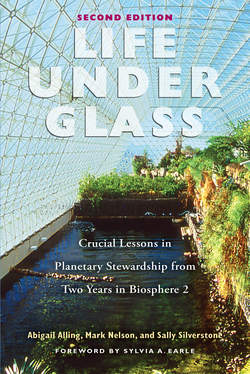Читать книгу Life Under Glass - Марк Нельсон - Страница 30
На сайте Литреса книга снята с продажи.
ОглавлениеNestled in the foothills of the Santa Catalina mountains north of Tucson, Arizona, the 3.15 acres Biosphere 2 facility is the world’s largest closed ecological system. Inside are tropical rainforest, savannah, desert, mangrove marsh, coral reef biomes, a half-acre farm, and human living area.
Schematic of Biosphere 2, built for one hundred years of operation, each of its biomes covered about half an acre and with deep soil/sediment tanks that were lined with stainless steel below ground and airtight space frame roofs above. The white geodesic domes covered its two variable volume “lungs” which allowed the facility’s air to expand and contract without damaging the structure.
Biosphere 2’s Mission Control housed a key part of the facility’s “Nerve System,” allowing outside scientists and IT specialists access to the data being collected.
Biosphere 2’s operation required the expertise of many scientists and engineers. A sophisticated real-time data and sensor computer network, state-of-the-art for its time, facilitated the flow of information to and from the facility.
Taber in the Analytic Laboratory in Biosphere 2. The lab used no toxic chemicals and was equipped to make very detailed analyses of our air and water.
In addition to automatic sensors distributed around Biosphere 2, hand-collected samples of air, water, biomass, and soil were gathered for periodic analysis and to augment research studies. Here, air samples are collected in the savannah.
Biosphere 2’s constructed coral reef included around three dozen coral species, of which only one was lost during the experiment. Its operation yielded important insights into the potential impacts of climate change on ocean health.
This map of the coral reef was done within two weeks of the end of the two-year closure. Living stony coral species are colored, with thin black lines representing seagrasses. Black colors represent dead colonies of all species. Depth was measured to generate a bathymetric contour map which was digitized and merged with the coral file to generate the final image.
Several times a week, Gaie dove in the Biosphere 2 ocean to garden the corals and inspect the health of the reef.
The coral reef biome involved daily management and careful observation which included measurements of ocean water chemistry, weeding algae to remove nutrients, maintaining the pumps, wave machine, and other technical support systems.
A botanist in a new world, Linda measures inter-nodal lengths on a desert plant. Research conducted before, during, and after the closure experiment tracked the development of all the wilderness biomes.
In the rainforest, Linda reseeds planting pockets of the cloud forest mountain overlooking the lowland forest area. Fast-growing trees formed the initial canopy, protecting light-sensitive ones which will dominate the rainforest as it matures.
The desert was modeled on coastal fog deserts like that of Baja, California. Each biomic area includes a variety of ecosystems with characteristic soils, streams/waterfalls/pools, and vegetation.
The rainforest soon after closure, looking towards the cloud forest mountain. Water overflowed the pool at its top, creating a waterfall into Tiger Pond at its base and flowing through the meandering stream of the varzea, the low-lying floodplain rainforest.
The intensive half-acre farm had 18 plots, including rice paddies with rotating seasonal crops. The farm was one of the world’s most productive, supplying over 80% of the biospherian diet for two years with more than 80 crops for food variety.
The mangrove marsh biome was modeled on an Everglades, Florida estuary. Its zones went from freshwater marsh through five more ecosystems of increasing salinity, including oyster beds, white, black, and red mangroves. The mangrove marsh grew rapidly and studies confirmed its ecology closely resembled the natural areas where it was collected.
